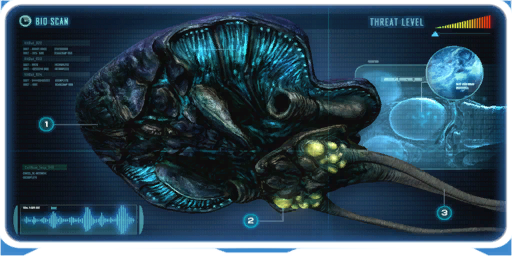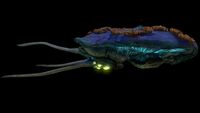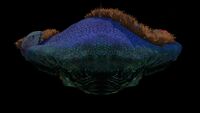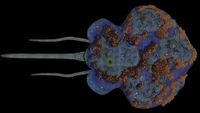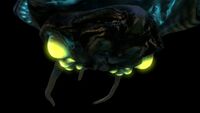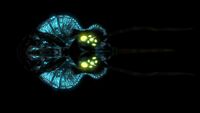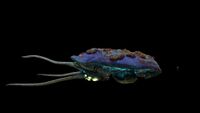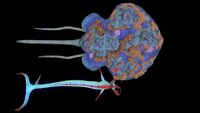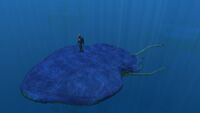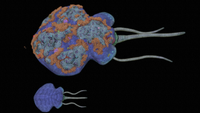Reefback Leviathan: Difference between revisions
mNo edit summary |
MilotronZeta (talk | contribs) m (added redwort to the "flora" section) |
||
| (82 intermediate revisions by 51 users not shown) | |||
| Line 1: | Line 1: | ||
{{ |
<div class="ItemTabber"><tabber>Fauna={{Fauna|title1 = Reefback Leviathan |
||
|image1 = |
|image1 = |
||
<gallery> |
<gallery widths="200" spacing="small"> |
||
Reefback Fauna.png|Adult |
Reefback Fauna.png|Adult |
||
Reefback Leviathan Juvenile Fauna.png|Juvenile |
|||
</gallery> |
</gallery> |
||
|category = Herbivores |
|category = Herbivores |
||
|tab = [[Fauna]] |
|tab = [[Fauna]] |
||
|attitude = [[:Category: Attitude: Passive|Passive]] |
|attitude = [[:Category: Attitude: Passive|Passive]] |
||
|biome = * [[ |
|biome = * [[Bulb Zone]] |
||
* [[Crag Field]] |
|||
* [[Dunes]] |
* [[Dunes]] |
||
* [[Grassy Plateaus]] |
* [[Grassy Plateaus]] |
||
* [[Bulb Zone]] |
|||
* [[Mushroom Forest]] |
* [[Mushroom Forest]] |
||
* [[Sparse Reef]] |
* [[Sparse Reef]] |
||
* [[Underwater Islands]] |
* [[Underwater Islands]] |
||
|active_during = [[:Category:Cathemeral|Cathemeral (Day and Night)]] |
|active_during = [[:Category:Cathemeral|Cathemeral (Day and Night)]] |
||
|debugspawn = ''reefback'' ''reefbackbaby'' |
|||
|description = Large herbivorous lifeform, raised in containment. |
|||
|debug_spawn = |
|||
'''Adult:''' <i>reefback</i> |
|||
'''Juvenile''':<i>2560</i> |
|||
|image2 = Reefback Egg.png |
|||
|tab2 = [[Eggs]] |
|||
|description2 = Incredibly, Reefbacks hatch from these. |
|||
|biome2 = * - |
|||
|size = |
|||
* [[File:Reefback Egg.png|30px]] 9 (3x3) |
|||
* [[File:Reefback.png|30px]] 16 (4x4) |
|||
|bioreactor = * [[File:Reefback Egg.png|30px]] +280 Energy |
|||
* [[File:Reefback.png|30px]] +840 Energy |
|||
|dna = |
|||
|length= 70 meters |
|||
|item_id = <i>reefbackegg</i> |
|||
|incubation = * [[File:Alien Containment.png|30px|link=Alien Containment]] 3 (day/s) |
|||
|health = 10,000 |
|health = 10,000 |
||
}} |
|||
}}The '''Reefback''' '''Leviathan''' is a passive [[Leviathan Class Organisms|leviathan class]] [[fauna]] species. It is the second largest passive life form, and ties with the [[Sea Dragon Leviathan]] for second largest creature overall. |
|||
|-| |
|||
Item= |
|||
{{Craftable| |
|||
title1 = Reefback |
|||
|image4= Reefback.png |
|||
|category = [[Fauna]] |
|||
|description =Large herbivorous lifeform, raised in containment. |
|||
|acqired_from = |
|||
* '''Reefback Eggs''' |
|||
|size = |
|||
* 16 (4×4) |
|||
|bioreactor = |
|||
* 840 |
|||
|debugspawn= ''reefback'' |
|||
}} |
|||
|-| |
|||
Egg= |
|||
{{Craftable| |
|||
title1 = Reefback Egg |
|||
|image4= Reefback Egg.png |
|||
|category = [[Eggs]] |
|||
|description=Incredibly, Reefbacks hatch from these. |
|||
|acqired_from = |
|||
* [[Alien Containment (Subnautica)|Reefbacks]] |
|||
|size = |
|||
*9 (3×3) |
|||
|biome =''Unimplemented'' |
|||
|incubation = |
|||
* 3 (day/s) |
|||
|bioreactor = |
|||
* 280 |
|||
|debugspawn = <i>reefbackegg</i> |
|||
}} |
|||
</tabber></div> |
|||
The '''Reefback''' '''Leviathan''' is a passive [[Leviathan Class Organisms|leviathan class]] [[fauna]] species. It is the third largest passive life form. |
|||
==Appearance== |
==Appearance== |
||
The Reefback is massive in size, with most of the creature's body being comprised of a thick, dark-blue carapace with a rounded, triangular front, and a relatively small body concentrated in the posterior. Attached to its main body are three long whip-like tentacles. |
The Reefback is massive in size, with most of the creature's body being comprised of a thick, dark-blue carapace with a rounded, triangular front, and a relatively small body concentrated in the posterior. Attached to its main body are three long whip-like tentacles. |
||
An adult Reefback has patches of teal-colored coral and brown-colored grass growing across its carapace, befitting its name, while the younger ones lack this trait. The carapace has a slightly bright blue dotted pattern across towards the back. |
An adult Reefback has patches of teal-colored coral and brown-colored grass growing across its carapace, befitting its name, while the younger ones lack this trait. The carapace has a slightly bright blue dotted pattern across towards the back. Beneath its carapace, it is dark green with light blue [[Bioluminescence|bioluminescent]] stripes on the sides and in the middle. On either side of its body are eight yellow bioluminescent bulbs. The purpose of these is unknown, though the data bank entry notes a visual similarity to the [[Gasopod]] algae gland. Although they could be the Leviathan's eyes, it remains unclear as the PDA states they serve an unknown function in the digestive system. Two siphon-esque structures that constantly expand and retract as the creature moves are located next to these bulbs. While not explicitly states, this likely means it breathes via ram ventilation. |
||
On the back of the Reefback, there are giant tubes. These seem to be where the calls of the Reefback come from. |
|||
==Behavior== |
==Behavior== |
||
The Reefback drifts slowly and gently around the open waters of many [[biomes]], mostly seen swimming in pods of more than two. It |
The Reefback drifts slowly and gently around the open waters of many [[Biomes (Subnautica)|biomes]], mostly seen swimming in pods of more than two. It rarely adjusts its current altitude, unless bumped against obstacles. |
||
Juvenile Reefbacks are a quarter the size of an adult. They can often be found with adults in certain locations. |
Juvenile Reefbacks are a quarter the size of an adult. They can often be found with adults in certain locations. |
||
| Line 48: | Line 70: | ||
The Reefback will frequently emit a range of echoing, low-frequency calls. They will only emit these calls if there are other Reefbacks nearby. This suggests that these calls are a form of communication, as opposed to echolocation. |
The Reefback will frequently emit a range of echoing, low-frequency calls. They will only emit these calls if there are other Reefbacks nearby. This suggests that these calls are a form of communication, as opposed to echolocation. |
||
When Reefbacks are exposed to damage, their tentacles will wave quickly and they will move slightly faster for a brief period. |
When Reefbacks are exposed to damage, their tentacles will wave quickly and they will move slightly faster for a brief period. When killed, their models and hitboxes completely disappear however the flora on their backs stay and fall towards the sea floor. |
||
==Mini-ecosystem== |
==Mini-ecosystem== |
||
Adult Reefbacks can support mini-ecosystems on their back. These ecosystems include many types of [[flora]] and [[coral]], along with other small fauna swimming in the vicinity of the gentle giants. Some caution should be taken when approaching Reefbacks, as [[Tiger Plant]]s often make their homes on their backs. Adult Reefbacks often have barnacles growing on their back. These |
Adult Reefbacks can support mini-ecosystems on their back. These ecosystems include many types of [[flora]] and [[coral]], along with other small fauna swimming in the vicinity of the gentle giants. Some caution should be taken when approaching Reefbacks, as [[Tiger Plant]]s often make their homes on their backs. Adult Reefbacks often have barnacles growing on their back. These [[barnacle]]s are Harvesting Nodes and can be broken to reveal resources, similar to limestone, shale, or sandstone outcrops. Currently, they only drop two resources: [[Silver Ore]] and [[Copper Ore (Subnautica)|Copper Ore]]. Copper ore is the most frequent resource to find. |
||
<tabber> |
<tabber> |
||
Fauna= |
Fauna= |
||
* [[Biter]] |
* [[Biter]] |
||
* [[Bladderfish]] |
* [[Bladderfish (Subnautica)|Bladderfish]] |
||
* [[Boomerang]] |
* [[Boomerang (Subnautica)|Boomerang]] |
||
* [[Eyeye]] |
* [[Eyeye]] |
||
* [[Holefish]] |
* [[Holefish]] |
||
| Line 71: | Line 93: | ||
*[[Blood Grass]] |
*[[Blood Grass]] |
||
*[[Furled Papyrus]] |
*[[Furled Papyrus]] |
||
*[[Redwort (Subnautica)|Redwort]] |
|||
*[[Regress Shell]] |
*[[Regress Shell]] |
||
*[[Rouge Cradle]] |
*[[Rouge Cradle]] |
||
| Line 80: | Line 103: | ||
|-| |
|-| |
||
Coral= |
Coral= |
||
* [[Coral Shell Plate]] |
|||
* [[Brain Coral]] |
* [[Brain Coral]] |
||
* [[Slanted Shell Plate]] |
* [[Coral Shell Plate|Slanted Shell Plate]] |
||
* [[Table Coral]] |
* [[Table Coral]] |
||
*[[Coral Shell Plate|Veined Shell Plate]] |
|||
|-| |
|-| |
||
Harvesting Node= |
Harvesting Node= |
||
| Line 90: | Line 113: | ||
==Energy Value== |
==Energy Value== |
||
{{Recipe2}} |
{{Recipe2|page=Reefback}}<nowiki> |
||
</nowiki> |
|||
{{Recipe2|page = Reefback Egg}} |
|||
{{Recipe2|page=Reefback Egg}} |
|||
==Data Bank Entry== |
==Data Bank Entry== |
||
| Line 101: | Line 126: | ||
This vast lifeform is in excess of 30m long and has been designated leviathan class. Fortunately it feeds exclusively on plankton-like lifeforms in the water. |
This vast lifeform is in excess of 30m long and has been designated leviathan class. Fortunately it feeds exclusively on plankton-like lifeforms in the water. |
||
1. Chitinous Shell:<br /> |
|||
# Chitinous Shell:<br />Most of the lifeform's topside and some of its underside is protected by a thick, layered exoskeleton. This suggests an evolutionary path quite different from other organisms on 4546B, most of which are vertebrate in nature. The reefback species has likely been able to grow far larger than other herbivores because anything large enough to break through its shell has long since gone extinct.<br /> |
|||
Most of the lifeform's topside and some of its underside is protected by a thick, layered exoskeleton. This suggests an evolutionary path quite different from other organisms on 4546B, most of which are vertebrate in nature. The reefback species has likely been able to grow far larger than other herbivores because anything large enough to break through its shell has long since gone extinct. |
|||
# Enzyme Pods:<br />Similar in appearance to the algae glands of the gasopod, these organs on the reefback's underside serve some unknown purpose in its digestive system, and are capable of expelling small quantities of stomach enzymes into the surrounding waters.<br /> |
|||
# Local Microcosm:<br />An array of different barnacle and plant species grow on the reefback's shell, thrusting their roots into ancient scars in the chitin, and taking advantage of their mobility to avoid predation. Nonetheless reefbacks will often be pursued by the faster, hungrier herbivores, and thus this leviathan species is a mobile microcosm worthy of years of study in itself.<br /> |
|||
# Lifecycle:<br />Reefbacks's lifespans likely extend through many centuries, should they survive their initial growth cycle. For the first few decades their smaller size would make them vulnerable to carnivorous leviathans. Sociable, seen traveling in small pods and communicating by an echoing call, behavior is consistent with low-level sentience. |
|||
2. Enzyme Pods:<br /> |
|||
Similar in appearance to the algae glands of the gasopod, these organs on the reefback's underside serve some unknown purpose in its digestive system, and are capable of expelling small quantities of stomach enzymes into the surrounding waters. |
|||
3. Local Microcosm:<br /> |
|||
An array of different barnacle and plant species grow on the reefback's shell, thrusting their roots into ancient scars in the chitin, and taking advantage of their mobility to avoid predation. Nonetheless reefbacks will often be pursued by the faster, hungrier herbivores, and thus this leviathan species is a mobile microcosm worthy of years of study in itself. |
|||
4. Lifecycle:<br /> |
|||
Reefbacks's lifespans likely extend through many centuries, should they survive their initial growth cycle. For the first few decades their smaller size would make them vulnerable to carnivorous leviathans. Sociable, seen traveling in small pods and communicating by an echoing call, behavior is consistent with low-level sentience. |
|||
Assessment: Harbors plants, small fish and metal-rich barnacles |
Assessment: Harbors plants, small fish and metal-rich barnacles |
||
| Line 119: | Line 150: | ||
Reefback12.jpg|Lower extremities |
Reefback12.jpg|Lower extremities |
||
Newreefback4.jpg|Bioluminescence |
Newreefback4.jpg|Bioluminescence |
||
Reefback Size Reference.jpg|Size comparison between an adult Reefback and the [[Ryley Robinson|player]] |
|||
reeeeeeeeeeef.jpg|Size comparison with a [[Reaper Leviathan]] |
reeeeeeeeeeef.jpg|Size comparison with a [[Reaper Leviathan]] |
||
ReefbackJuvenileSizeref.jpg|A size comparison between a juvenile Reefback and the player |
ReefbackJuvenileSizeref.jpg|A size comparison between a juvenile Reefback and the player |
||
RbBKZ.png|A Reefback above the [[Blood Kelp |
RbBKZ.png|A Reefback above the [[Blood Kelp Trench]] |
||
RbGP.png|Comparison between adult and juvenile Reefbacks |
|||
RbDunes.png|A single Reefback in the [[Dunes]] |
|||
RbGP.png|An adult and juvenile Reefback in the [[Grassy Plateaus]] |
|||
RbKoosh.png|Two adult Reefbacks in the [[Bulb Zone]] |
|||
2017-05-23_00002.jpg|A Reefback, close enough to the surface for the player to "ride" |
2017-05-23_00002.jpg|A Reefback, close enough to the surface for the player to "ride" |
||
</gallery> |
</gallery> |
||
| Line 136: | Line 165: | ||
== Trivia == |
== Trivia == |
||
* [[ |
* [[Bladderfish (Subnautica)|Bladderfish]] and [[Holefish]] [[Shoal of Fish|Schools]] can only be found near Reefbacks and do not naturally spawn anywhere else. |
||
* Reefbacks are capable of transporting the [[player]] when near the surface. |
* Reefbacks are capable of transporting the [[Ryley Robinson|player]] when near the surface. |
||
** While this may provide safety from nearby predators, it would be much faster to just swim manually underwater. |
|||
* Juveniles can be found infected with Kharaa, whereas the adults can not. |
|||
* Juveniles can be found infected with [[Kharaa]], whereas the adults cannot. |
|||
* Reefbacks were initially intended to submerge themselves in sandy areas. Increased activity about them would have made them rise in search for a peaceful place to rest.<ref>https://docs.google.com/document/d/1kd4YTHJz2K4ERdGRfJB-8M7_32Q23clIBRqEMrLmysk/edit#</ref> It is unknown if this will be implemented. |
|||
* |
* Reefbacks were initially intended to submerge themselves in sandy areas. Increased activity around them would have made them rise in search of a peaceful place to rest.<ref>https://docs.google.com/document/d/1kd4YTHJz2K4ERdGRfJB-8M7_32Q23clIBRqEMrLmysk/edit#</ref> |
||
** Another intended interaction would've been that the player could grab hold of a Reefback's tentacles to hitch a ride or hide on their plant-covered backs to hide from predators.<ref>https://docs.google.com/document/d/1kd4YTHJz2K4ERdGRfJB-8M7_32Q23clIBRqEMrLmysk/edit</ref> |
|||
* Reefbacks were formerly much smaller than they currently are, and had the same texture that is currently given to juvenile Reefbacks. |
|||
* Reefbacks were formerly much smaller than they currently are, and had the same texture that is currently given to juvenile Reefbacks. |
|||
*The game refers to Reefbacks as herbivores, yet the data bank entry states that they are planktivorous. |
|||
* The game refers to Reefbacks as herbivores, yet the data bank entry states that they are planktivorous. |
|||
* The underside of a Reefback greatly resembles that of the [https://half-life.fandom.com/wiki/Combine_Gunship Combine Gunship] from the game ''[https://half-life.fandom.com/wiki/Half-Life_2 Half Life 2]''. |
|||
* Reefbacks can travel at 0.5 meters per second. |
|||
* Reefbacks are the only animals that don't have a death animation. |
|||
* Reefbacks previously used to be able to make bubbling noises in the earlier versions. It's unknown why these were removed. |
|||
* Reefbacks are tied with the Cuddlefish at the highest health of a killable fauna. |
|||
==References== |
==References== |
||
<references /> |
<references /> |
||
== Bugs == |
|||
* Reefbacks can ocassionally wander into the [[Safe Shallows]]. |
|||
{{Navbox Fauna}} |
{{Navbox Fauna}} |
||
[[Category:Attitude: Passive]] |
|||
[[de:Riffrücken]] |
|||
[[es:Portarrecife_Leviatán]] |
|||
[[fr:Reefback_Léviathan]] |
|||
[[pl:Rafogrzbiet]] |
|||
[[ru:Рифоспин]] |
|||
[[Category:Passive]] |
|||
[[Category:Bioluminescent]] |
[[Category:Bioluminescent]] |
||
[[Category:Blood Kelp Zone]] |
[[Category:Blood Kelp Zone]] |
||
| Line 161: | Line 207: | ||
[[Category:Underwater Islands]] |
[[Category:Underwater Islands]] |
||
[[Category:Leviathan Class]] |
[[Category:Leviathan Class]] |
||
[[Category:Creatures with variants]] |
|||
[[Category:Bioreactor Fuel]] |
|||
Latest revision as of 16:07, 28 February 2025
<title source="title1" style="font-weight:bold; text-align:center;"> <default>Reefback Leviathan</default> </title> <image source="image1"></image> <label>Category</label> <label>Tab</label> <label>Description</label> <label>Affiliation</label> <format></format> <label>Age</label> <label>Description when cooked</label> <label>Description when cured</label> <label>Inhabit</label> <label>Attitude</label> <label>Health</label> <label>Damage</label> <label>Adult Damage</label> <label>Juvenile Damage</label> <label>Drops</label> <label>Perks</label> <label>Biome</label> <label>Active During</label> <label>Size</label> <label>Length</label> <label>Bioreactor</label> <label>DNA</label> <label>Voice Actor</label> <label>Debug Spawn</label> <format>
- {{#explode:reefback reefbackbaby||0}}
- {{#explode:reefback reefbackbaby||1}}
- {{#explode:reefback reefbackbaby||2}}
- {{#explode:reefback reefbackbaby||3}}
- {{#explode:{{{item_id}}}||0}}
- {{#explode:{{{item_id}}}||1}}
- {{#explode:{{{item_id}}}||2}}
- {{#explode:{{{item_id}}}||3}}
- {{#explode:{{{debugspawn2}}}||0}}
- {{#explode:{{{debugspawn2}}}||1}}
- {{#explode:{{{debugspawn2}}}||2}}
- {{#explode:{{{debugspawn2}}}||3}}
The Reefback Leviathan is a passive leviathan class fauna species. It is the third largest passive life form.
Appearance
The Reefback is massive in size, with most of the creature's body being comprised of a thick, dark-blue carapace with a rounded, triangular front, and a relatively small body concentrated in the posterior. Attached to its main body are three long whip-like tentacles.
An adult Reefback has patches of teal-colored coral and brown-colored grass growing across its carapace, befitting its name, while the younger ones lack this trait. The carapace has a slightly bright blue dotted pattern across towards the back. Beneath its carapace, it is dark green with light blue bioluminescent stripes on the sides and in the middle. On either side of its body are eight yellow bioluminescent bulbs. The purpose of these is unknown, though the data bank entry notes a visual similarity to the Gasopod algae gland. Although they could be the Leviathan's eyes, it remains unclear as the PDA states they serve an unknown function in the digestive system. Two siphon-esque structures that constantly expand and retract as the creature moves are located next to these bulbs. While not explicitly states, this likely means it breathes via ram ventilation.
On the back of the Reefback, there are giant tubes. These seem to be where the calls of the Reefback come from.
Behavior
The Reefback drifts slowly and gently around the open waters of many biomes, mostly seen swimming in pods of more than two. It rarely adjusts its current altitude, unless bumped against obstacles.
Juvenile Reefbacks are a quarter the size of an adult. They can often be found with adults in certain locations.
The Reefback will frequently emit a range of echoing, low-frequency calls. They will only emit these calls if there are other Reefbacks nearby. This suggests that these calls are a form of communication, as opposed to echolocation.
When Reefbacks are exposed to damage, their tentacles will wave quickly and they will move slightly faster for a brief period. When killed, their models and hitboxes completely disappear however the flora on their backs stay and fall towards the sea floor.
Mini-ecosystem
Adult Reefbacks can support mini-ecosystems on their back. These ecosystems include many types of flora and coral, along with other small fauna swimming in the vicinity of the gentle giants. Some caution should be taken when approaching Reefbacks, as Tiger Plants often make their homes on their backs. Adult Reefbacks often have barnacles growing on their back. These barnacles are Harvesting Nodes and can be broken to reveal resources, similar to limestone, shale, or sandstone outcrops. Currently, they only drop two resources: Silver Ore and Copper Ore. Copper ore is the most frequent resource to find.
<tabber> Fauna=
- Biter
- Bladderfish
- Boomerang
- Eyeye
- Holefish
- Hoopfish
- Hoverfish
- Peeper
- Reginald
- Shoal of Fish
- Spadefish
|-| Flora=
- Acid Mushroom
- Blood Grass
- Furled Papyrus
- Redwort
- Regress Shell
- Rouge Cradle
- Spotted Reeds
- Tiger Plant
- Veined Nettle
- Violet Beau
- Writhing Weed
|-| Coral=
|-| Harvesting Node=
</tabber>
Energy Value
Data Bank Entry
|
This vast lifeform is in excess of 30m long and has been designated leviathan class. Fortunately it feeds exclusively on plankton-like lifeforms in the water. 1. Chitinous Shell: 2. Enzyme Pods: 3. Local Microcosm: 4. Lifecycle: Assessment: Harbors plants, small fish and metal-rich barnacles |
Gallery
<tabber> Screenshots=
Size comparison between an adult Reefback and the player
Size comparison with a Reaper Leviathan
A Reefback above the Blood Kelp Trench
|-| Concept Art=
</tabber>
Trivia
- Bladderfish and Holefish Schools can only be found near Reefbacks and do not naturally spawn anywhere else.
- Reefbacks are capable of transporting the player when near the surface.
- While this may provide safety from nearby predators, it would be much faster to just swim manually underwater.
- Juveniles can be found infected with Kharaa, whereas the adults cannot.
- Reefbacks were initially intended to submerge themselves in sandy areas. Increased activity around them would have made them rise in search of a peaceful place to rest.[1]
- Another intended interaction would've been that the player could grab hold of a Reefback's tentacles to hitch a ride or hide on their plant-covered backs to hide from predators.[2]
- Reefbacks were formerly much smaller than they currently are, and had the same texture that is currently given to juvenile Reefbacks.
- The game refers to Reefbacks as herbivores, yet the data bank entry states that they are planktivorous.
- The underside of a Reefback greatly resembles that of the Combine Gunship from the game Half Life 2.
- Reefbacks can travel at 0.5 meters per second.
- Reefbacks are the only animals that don't have a death animation.
- Reefbacks previously used to be able to make bubbling noises in the earlier versions. It's unknown why these were removed.
- Reefbacks are tied with the Cuddlefish at the highest health of a killable fauna.
References
Bugs
- Reefbacks can ocassionally wander into the Safe Shallows.
Lua error in package.lua at line 80: module 'Dev:Navbox' not found.





